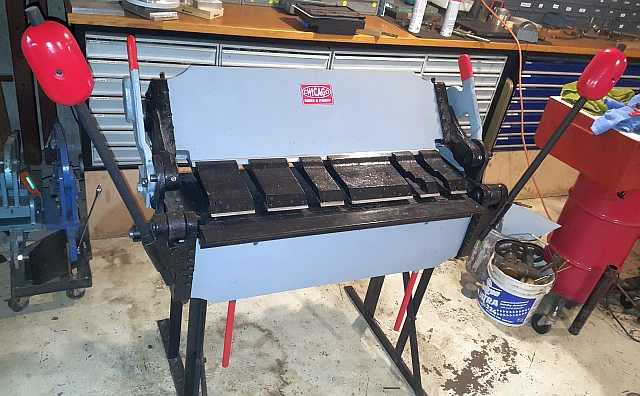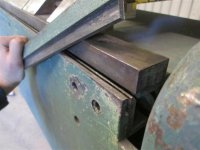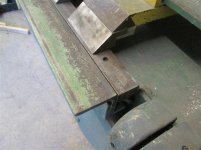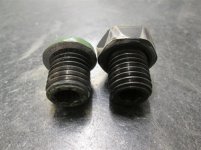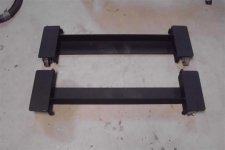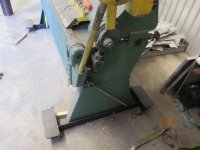Boxcar
Plastic
- Joined
- Jun 30, 2014
- Location
- Florida Panhandle
I recently picked up this old break...saved it from a metal recycler business.

Before there's any confusion... The picture of the rusty one is mine and I had already stripped off the easily removable parts before I moved it.
Was lucky to have found it nearly complete... So far, I believe I'm only missing a part of the apron (If my nomenclature is correct... the assembly that rotates and provides the force to bend)There's an angle channel that is missing.. it's bolted to the face of the apron when attached. While the unit was very complete I do find it odd that it was the only thing missing. All the fingers are present, counter balances, and some misc. parts that I have yet to figure out what they are.
Two questions... and as I'm not at the machinist level... please bear with me.
1. The individual fingers are comprised of a few different parts... my question on that is that there seems to be some painted surfaces and some not. I did a complete teardown of mine before I dropped off to the sandblaster. I'm looking for guidance on what to repaint and what to not paint. Please allow me some latitude in presenting my own naming convention to the parts of the fingers as I describe my thoughts of painted surfaces and non-painted. First: the nose of the finger should not be painted (at least not on the bottom as it contacts the steel that is being held for bending) However, as for the top of the nose...mine appears to have been painted originally and was gone over with yellow thru the years. Thoughts? could keep the entire nose paint free and dress up the steel to a machine like finish.
Second: The largest section of the assembly... I'll call the carrier. I'd say the top and the sides could be painted but as the bottom side comes in contact with the sheet steel.. I'd guess no paint there. And finally, there's a aluminum block that I'll just clean up and assemble as is. Thought's/considerations with regards to the fingers?
 not mine, example only
not mine, example only
 not mine, example only
not mine, example only
Second topic... with regards to the missing apron component. I'd guess that a replacement to this part could be costly (I'll be checking with Dreis & Krump next week... But could there be a more local alternative that I can cut/fit/drill myself. Would this be a specialized steel? What type? I have some metal specialty businesses near that may have something providing it's not too unique.
 mine, shows the missing L channel on front of the apron
mine, shows the missing L channel on front of the apron
 not mine, shows the channel in place on the apron.
not mine, shows the channel in place on the apron.
Pics below...thanks in advance for helping/taking the time to look this over.
Finally... I mulled over how the hell I'm going to handle moving this around during the refurb/placement phase... lucky to have a few aircraft roller lying around the shop...cut them down and mounted to a sacrificial board...worked good so far...handles the weight just fine...each roller can handle over 1600lbs each if memory serves me correctly.


I'll probably burn for this but... I was in a rush to pick the brake up and get it to the blaster/painter. While I did want to make some brackets to mechanically fasten the rollers to the plywood... I didn't have the time or hardware to get it done.... SOOO, I glued and nailed some blocks in that secured the rollers to the plywood cart. There was a small lip on the roller conveyors that enabled me to simply catch with the blocks... a temporary dolly for sure.

Before there's any confusion... The picture of the rusty one is mine and I had already stripped off the easily removable parts before I moved it.
Was lucky to have found it nearly complete... So far, I believe I'm only missing a part of the apron (If my nomenclature is correct... the assembly that rotates and provides the force to bend)There's an angle channel that is missing.. it's bolted to the face of the apron when attached. While the unit was very complete I do find it odd that it was the only thing missing. All the fingers are present, counter balances, and some misc. parts that I have yet to figure out what they are.
Two questions... and as I'm not at the machinist level... please bear with me.
1. The individual fingers are comprised of a few different parts... my question on that is that there seems to be some painted surfaces and some not. I did a complete teardown of mine before I dropped off to the sandblaster. I'm looking for guidance on what to repaint and what to not paint. Please allow me some latitude in presenting my own naming convention to the parts of the fingers as I describe my thoughts of painted surfaces and non-painted. First: the nose of the finger should not be painted (at least not on the bottom as it contacts the steel that is being held for bending) However, as for the top of the nose...mine appears to have been painted originally and was gone over with yellow thru the years. Thoughts? could keep the entire nose paint free and dress up the steel to a machine like finish.
Second: The largest section of the assembly... I'll call the carrier. I'd say the top and the sides could be painted but as the bottom side comes in contact with the sheet steel.. I'd guess no paint there. And finally, there's a aluminum block that I'll just clean up and assemble as is. Thought's/considerations with regards to the fingers?


Second topic... with regards to the missing apron component. I'd guess that a replacement to this part could be costly (I'll be checking with Dreis & Krump next week... But could there be a more local alternative that I can cut/fit/drill myself. Would this be a specialized steel? What type? I have some metal specialty businesses near that may have something providing it's not too unique.


Pics below...thanks in advance for helping/taking the time to look this over.
Finally... I mulled over how the hell I'm going to handle moving this around during the refurb/placement phase... lucky to have a few aircraft roller lying around the shop...cut them down and mounted to a sacrificial board...worked good so far...handles the weight just fine...each roller can handle over 1600lbs each if memory serves me correctly.


I'll probably burn for this but... I was in a rush to pick the brake up and get it to the blaster/painter. While I did want to make some brackets to mechanically fasten the rollers to the plywood... I didn't have the time or hardware to get it done.... SOOO, I glued and nailed some blocks in that secured the rollers to the plywood cart. There was a small lip on the roller conveyors that enabled me to simply catch with the blocks... a temporary dolly for sure.








